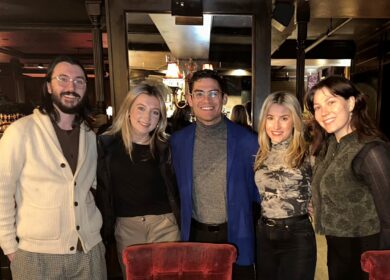
By Cecilia Zhong, Senior Account Executive
“Cecilia’s company is sending her to work in Asia for four months,” said my husband to his boss.
“You are not gonna quit and join her company, are you?” asked his boss, half-jokingly.
They were talking about the sweet gig I got: a 15-week work trip across Hong Kong, Shanghai, Beijing and Singapore. As Silicon Valley tech companies compete in an arms race of perks, something like this doesn’t happen every day. I was fortunate enough to have embarked on a journey that aligned personal goals with the company roadmap.

It all started with “Building Bridges,” Hoffman’s career development program that immerses its employees in one or multiple foreign offices for several months. Basically, Hoffman pays you to work abroad.
Since 2016, the San Jose office has hosted colleagues from Singapore and Hong Kong. My teammate Kelly Trom gained her first taste of Asia through the Building Bridges program to Hong Kong in 2018.
To me, a born-and-raised Chinese national who’s studied, lived and worked in America for more than seven years, this program offers a perfect platform to fulfill my aspiration: becoming a bridge between China and the U.S. So I raised my hand to apply for the program.
Considering my background, our APAC managing director Caroline Hsu designed the itinerary to focus on Shanghai and Beijing, sandwiched between Hoffman’s regional dual hubs — Hong Kong and Singapore. With that, flights were booked, accommodations were made. Before I knew it, I was waiting in the TSA line at SFO.
The program kicked off with two weeks in Hong Kong, followed by eight weeks in Shanghai and four weeks in Beijing, concluding with one week in Singapore. To my pleasant surprise, not only are these offices based in major cities, they’re all centrally located in the happening areas; that alone is well worth a visit.
In addition to city hopping and sightseeing, I reaped more than a handful of unforgettable Building Bridges moments.

Decoding Chinese PR Enigma
First off, I was thrilled to get my hands dirty in the real world of Chinese PR. In Shanghai, I got the opportunity to pitch Chinese reporters, coordinate a CEO media roundtable and support a product launch event.
If pitching in the U.S. goes “email first, phone second,” pitching in China goes “call first, WeChat second, WeChat moving forward, email may be never.” After a few nerve-wracking calls, I had a list of reporters on my WeChat contact page. From there the real conversation began.
Unlike in the U.S. where phone briefings are predominant, face-to-face meetings are crucial in China. Chinese media are also more accustomed to group interviews. If the reporters are in a different city, companies will fly them in and provide accommodations depending on budget.
Speaking of budget, we cannot overlook the media allowance or “transportation fee” — a distinctive feature of Chinese media relations. As to how this fee originated, a popular belief is that when foreign companies first entered China, they’d give reporters a certain allowance to cover the taxi fare, so that they wouldn’t be late for the press conference riding a bus or a bike.
There are a couple other versions, but all point to one root cause: the low income of Chinese journalists. As long as media allowance constitutes an important part of journalists’ income, the grey area will stand still. However, it doesn’t mean our clients can get the coverage exactly the way they wanted, especially not from quality business and tech titles.

So, is it really that easy to pitch Chinese media? True, Chinese reporters are generally more responsive and more willing to work with PR than their U.S. counterparts. But when it comes to the top tier, competition is the same in every market.
More profoundly, the interpersonal nature of Chinese media relations requires a different skillset from PR professionals beyond writing effective stories on paper: How to coordinate a 100-people media event? Where to seat which reporter at the round table? How do you interact with them in person? What are you going to talk about at lunch? A whole new world opened for me.
As the cherry on top, I met a special “pen friend” IRL — TechCrunch China reporter Rita Liao, who kindly played host to me in Hangzhou, showing me around the futuristic Alibaba campus and picturesque Xixi wetland park.

Living in China’s Magic Realism
The following story is not fictional.
A Day with WeChat
I started the day by scanning the WeChat QR code on my phone to take the subway. At work, I used WeChat to hold conference calls with clients, followed up with reporters and passed a few documents back and forth.
At lunch, coworkers and I didn’t feel like going out, so we ordered curry delivery using the link A sent to the office WeChat group. We paid A back on WeChat. After work, friends and I went to get hot pot at a popular restaurant. We scanned a QR code at front desk to get in line on WeChat then went shopping in the mall.
Inside the restaurant, there was no menu on the table, only a QR code sticker. We scanned it and selected the ingredients on our phones that went into our order. B checked out and sent a split bill to our chat group. We clicked the bill and paid B back.
Back to the apartment, I bought some books from a WeChat store, watched a few videos in a Mini Program, chatted with my family and scrolled my friends’ posts on Moments until bedtime.
What a day!
Every time I’ve gone back to China, I’ve experienced a little reverse culture shock. But this time working in Shanghai and Beijing for three months, it felt like living in a massive testbed for the latest tech innovations.
When I downloaded WeChat in 2012, it was no more than an alternative IM app that can make free internet calls. Today, WeChat is ubiquitous, and almost omnipotent. Tencent is therefore hailed “social media king” thanks to WeChat, QQ and its mobile games. But it’s by no means the only tech tycoon trying to take over my life. In the U.S., there is FANG (or FAANG or FAAMG); in China, there is BAT — T for Tencent, A for Alibaba. B, once stood for Baidu, is now being associated with ByteDance, TikTok’s parent company.
It’s a fierce battleground for internet dominance in China. Who will be the new BAT and what will the digital landscape look like in the next five years? Three years? I dare not imagine.
Meeting Amazing People Everywhere
The trip would not have been the same without the Hoffmanites I had the pleasure of knowing. Incredibly kind, fun, knowledgeable and welcoming, they made it so easy for me to fit in and so hard to say goodbye. Trust me, these people knew their way around making the guest feel at home. Above all, they took it as a personal mission to feed me well.
Since day one, I was taken on a non-stop palate tour from the sizzling deliciousness at Central’s dai pai dong (street food stalls) to the 4 p.m. boba and fried chicken rounds in the Shanghai office; from restaurant hopping in the bustling Wangfujing area to mind-blowing feasts at Singapore’s local favorite hawker centers.

Hoffman Hong Kong

Hoffman Shanghai

Hoffman Beijing

Hoffman Singapore
It has been a life-changing experience. It wouldn’t have happened without Lou, Syreeta, Kymra, Caroline, Marc, Frank and Mo championing the program. I also want to give a special shout-out to my “office moms”: Lydia, Kathy, Anita, DD, Wendy M. and Janice — you are simply AWESOME!
The Building Bridges program is over, but the building bridges effort continues. I look forward to working with the APAC teams on new fronts and helping businesses navigate opportunities on both sides of the Pacific.
Until next time.


